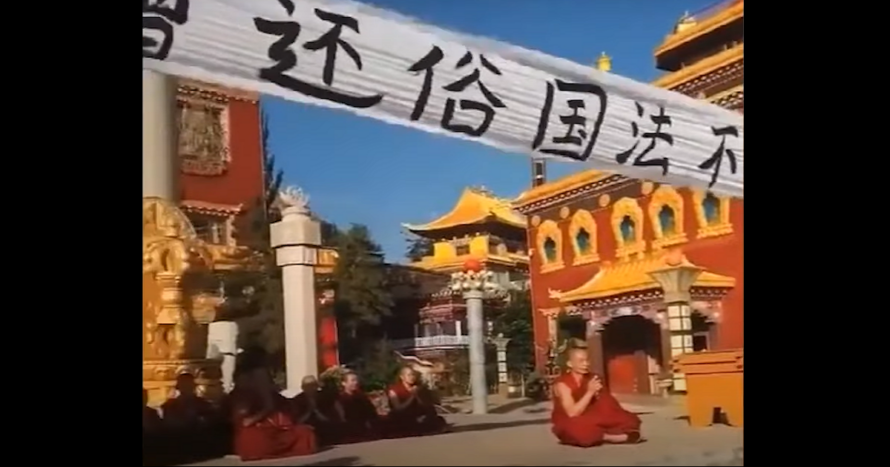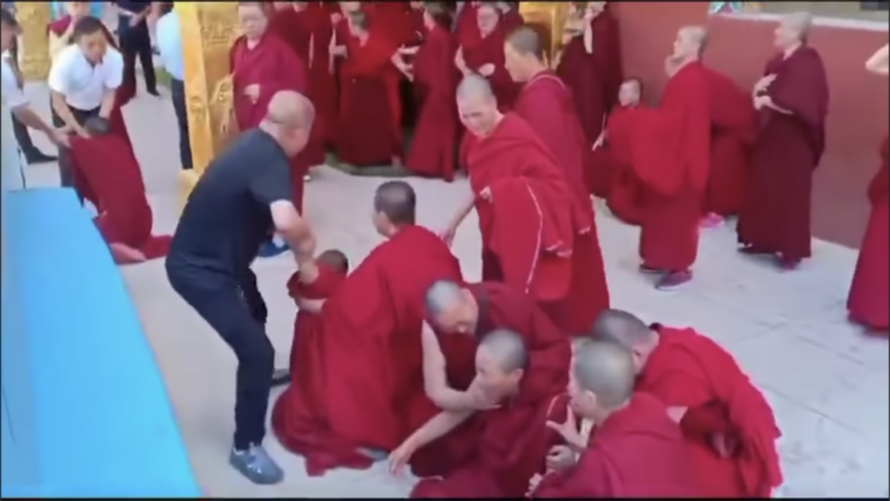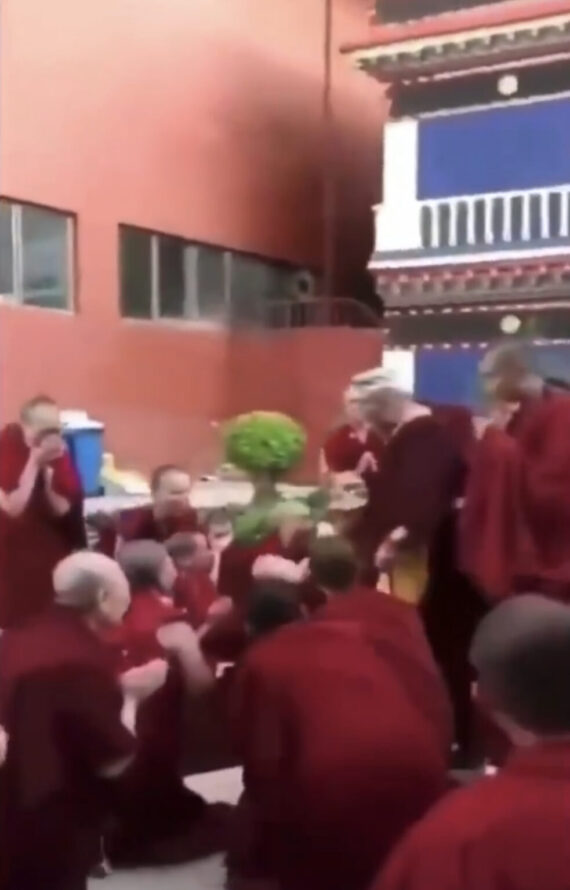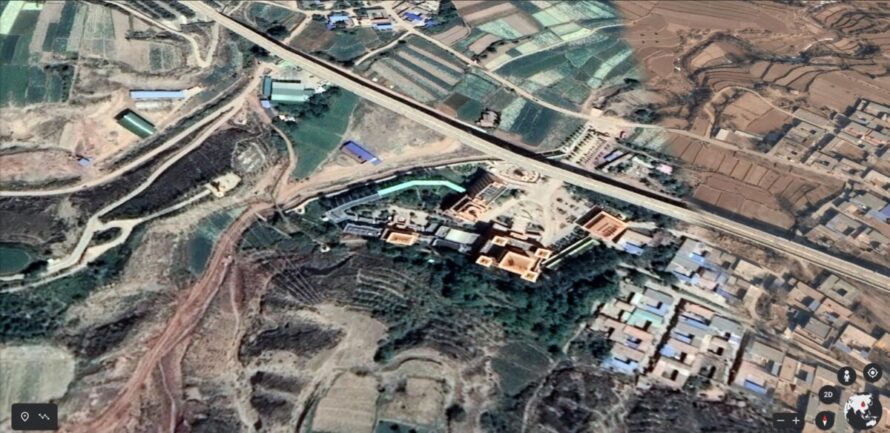Disturbing footage has emerged from China’s Gansu province, where local authorities shut down a Tibetan Buddhist monastery and ordered the monastics to disrobe.
Chinese diaspora media outlet Mingde reported on the situation at Kharmar (Chinese: Hongcheng) Monastery, with video clips depicting officials carrying out forced evictions, monastics staging a sit-in to protest having to leave their monastic lives, nuns crying as an elderly teacher walks down an aisle and a monk threatening to jump off a roof.
Although some local government officials feigned ignorance of the eviction, provided outright denials or declined to respond to inquiries by the US-based Radio Free Asia, one employee of the Yongjing county ethnic minority and religious affairs bureau gave a tacit confirmation, telling RFA that “Director Cui of the monastery management committee was responsible for resettling the monks and nuns.”
Chinese officials typically frame forced eviction as “resettlement” and arbitrary detention as receiving “political and legal education.”
Although the motive for shutting down the monastery is unclear, reports say it dates back to a donation the monastery allegedly made to help combat the COVID-19 pandemic in China.
“The shocking videos of the suffering of monks and nuns as they are evicted from Kharmar Monastery are a reminder of the human toll of China’s war on religion,” the International Campaign for Tibet said. “China’s persecution of Tibetan Buddhists is a tragedy that not only threatens the survival of Tibetan culture but also undermines the very idea of religious freedom around the globe. With China continuing to erode international norms and values, the world must speak for the rights of Tibetan monastics.”


Disturbing footage
Mingde published four video clips. The first one shows a group of nuns staging a sit-in chanting prayers with a large banner in Chinese characters reading, “Forcing the monastics to return to the secular life will not be tolerated by the national laws.”
The second clip shows a group of nuns crying as an elderly lama walks slowly, consoling the nuns in his path. Another clip shows plainclothes officials arriving at the monastery to forcibly evict the monastics, who appear to be exiting from the monastery’s assembly hall. In the same frame, female officials in civilian clothes rush up the steps to evict the nuns.
The fourth clip shows a monk threatening to jump off the roof while loudly shouting “go away!” at the officials on the ground inside the monastery premises.


Unclear motives behind the evictions
The reason for shutting down the monastery and forcibly evicting the monastics is unclear. The Mingde report states that troubles started unexpectedly when the monastery donated around 300,000 yuan as an empathetic gesture at the height of the COVID-19 pandemic in China. The authorities seized that as the pretext to demand the monastery’s share its wealth equally with the government.
While the International Campaign for Tibet could not confirm whether Kharmar Monastery donated the money or not, several Tibetan monasteries and communities donated generously for prevention initiatives during the outbreak of COVID in February 2020. For instance, Kumbum Monastery in eastern Tibet donated 1 million yuan to Wuhan for purchase of COVID prevention supplies like facemasks and goggles. Similarly, Minyak Pel temple in Dartsedo donated 130,000 yuan in solidarity with those in Wuhan and Tawu affected by the pandemic.
It’s likely that the local Chinese authorities in Yongjing County, where Kharmar Monastery is located, may have seized the donation made by the monastery as a pretext to harass and shut down the monastery. Chinese authorities view Tibetan Buddhism as a threat to China’s national security. Any activity involving mass mobilization, like raising funds in this instance, is also potentially a threat to national security and the political security of the Chinese Communist Party.
In recent years, Chinese President Xi Jinping has called for the prevention of Tibetan Buddhism spreading eastward into mainland China, and a Tibetan Buddhist institution outside of the areas with Tibetan autonomous status may have put Kharmar Monastery in greater danger.

Historic monastery
Kharmar (literally “red fort” in Tibetan) Monastery is located in the Linxia Hui Autonomous Prefecture, which directly borders the Kanlho Tibetan Autonomous Prefecture. Although the area does not presently have a sizable Tibetan population, it was historically a part of the Tibetan Empire, when the area was known as Gachu in Tibetan.
During the Mongol Empire, under the edict of Kublai Khan in the 13th century, a pagoda was established on that site to honor Drogon Chogyal Phagpa, the fifth leader of the Sakya school of Tibetan Buddhism and the first imperial preceptor of Kublai Khan’s Yuan Dynasty. With Kublai Khan’s patronage, Phagpa assumed political leadership of Tibet.
Kharmar Monastery was later built at the site of the pagoda. Both the pagoda and the monastery were destroyed during Mao Zedong’s Cultural Revolution, and restoration didn’t begin until 2011.
Tibetan monastery in a Hui prefecture
Although minority groups like Hui, Tu, Dongxiang and Tibetans account for around 50% of the population of Linxia prefecture, Yongjing County is predominantly Chinese, who made up 83% of the population in 2018.
Historically Linxia, formerly known as Hezhou, was an important frontier region for both Tibetans and non-Tibetans. Kharmar Monastery follows the Sakya school, one of the four schools of Tibetan Buddhism.